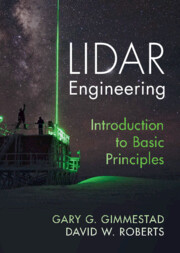Book contents
- Lidar Engineering
- Lidar Engineering
- Copyright page
- Dedication
- Contents
- Preface
- Glossary
- List of Abbreviations
- 1 Introduction
- 2 The Basic Lidar Models
- 3 The Molecular Atmosphere
- 4 Particles in the Atmosphere
- 5 Lidar Transmitters
- 6 Lidar Receivers and the Geometrical Function
- 7 Optomechanics
- 8 Optical Detection
- 9 Data Systems
- 10 Lidar Data Analysis
- 11 Applications
- Appendix A The Klett Retrieval
- Index
- References
10 - Lidar Data Analysis
Published online by Cambridge University Press: 16 February 2023
- Lidar Engineering
- Lidar Engineering
- Copyright page
- Dedication
- Contents
- Preface
- Glossary
- List of Abbreviations
- 1 Introduction
- 2 The Basic Lidar Models
- 3 The Molecular Atmosphere
- 4 Particles in the Atmosphere
- 5 Lidar Transmitters
- 6 Lidar Receivers and the Geometrical Function
- 7 Optomechanics
- 8 Optical Detection
- 9 Data Systems
- 10 Lidar Data Analysis
- 11 Applications
- Appendix A The Klett Retrieval
- Index
- References
Summary
Data analysis starts with preprocessing raw lidar data. Algorithms are presented and explained for digital filtering, background subtraction, range correction, and merging profiles from multiple receiver channels or from hybrid analog/digital data systems. Analysis techniques for cloud and aerosol lidar data are then illustrated, with examples of raw and range-corrected data followed by the scattering ratio, which can be used to find the transmittance of a cloud or aerosol layer. Analysis of depolarization data from co-polar and cross-polar receiver channels is discussed, and an algorithm is included for separating aerosol depolarization from the total atmospheric depolarization. Other simple techniques that do not require data inversion are then covered, including the slope method and multi-angle lidar. Finally, elastic backscatter lidar inversions are described, with a derivation of the Klett method for a single-component atmosphere (aerosols). The algorithms for a two-component atmosphere (molecules and aerosols) are presented, along with the limitations of this method.
Keywords
- Type
- Chapter
- Information
- Lidar EngineeringIntroduction to Basic Principles, pp. 268 - 296Publisher: Cambridge University PressPrint publication year: 2023

